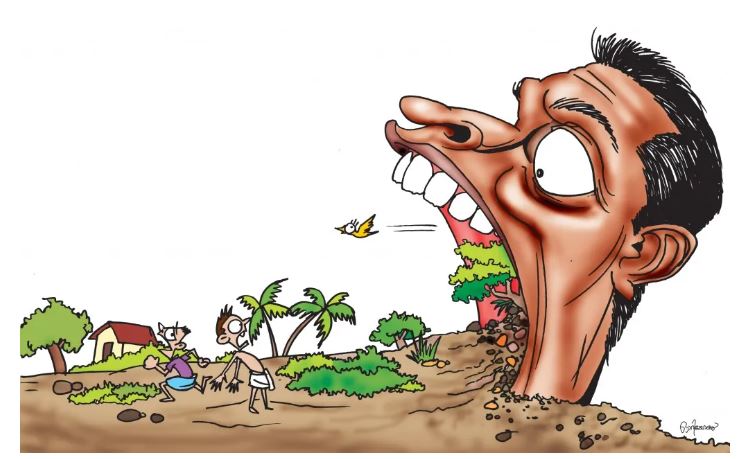By Dr Olav Albuquerque
LAND in Goa is what gold is to the Rann of Kutch in Gujarat. This is why moneybags from Delhi, Mumbai and elsewhere flock to Goa to buy second homes and third homes for their children and grandchildren, apart from making a fast buck by opening businesses like casinos, hotels and gambling adda or centers spread throughout the coastal areas of Calangute, Candolim, Baina in Vasco and elsewhere.
Some ministers profess to work for Goemkars during the day but count their crores of rupees in cash at night. When the sun goes down, prostitutes solicit men at Calangute and Candolim beaches. However, the beaches in south Goa are relatively freer from the twin menaces of prostitution and drug peddlers.
As with the police, there are lucrative and not-so-lucrative portfolios. The Town & Country Planning (TCP) department is the most lucrative portfolio because you can recover what you spend in campaigns during elections. This is why the allegations of Atanasio “Babush” Monserrate against TCP Minister Viswajit Rane have has been widely reported in the local media.
LAWLESS GOA NOW?
FOR those who came in late, Monserrate hit out at his cabinet colleague, Viswajit Rane, for indiscriminate land conversion without allegedly following the due process of law. Land parcels located in the orchard zone or forest zone are used by the underworld to build illegal houses and the owners are threatened or taunted to go to court if they dare.
The consequences will prove to be disastrous for Goa in the long run. Orchard zones are converted to settlement zones where alone construction activity is allowed. Agricultural income may be exempt from taxes but the taxes paid on building huge row houses and buildings on what was once orchard zones is a lucrative business. Builders who have ministers as their sleeping partners offer several lakh rupees to widows and others who own land — but need hard cash to raise their families.
“Viswajit Rane holds meetings and takes unilateral decisions to convert the land into settlement zones without the local MLA’s consent. The local MLA should be part of the decision-making process because if land is converted, it will harm the MLA’s constituency. If the MLA is kept in the dark, this will destroy the ecology and adversely affect land use,” said Monserrate.
“I am not going to keep quiet. I want to send a clear message to Viswajit Rane and others like him that no construction will be allowed on converted land within Panjim. These decisions have been taken without consulting the local MLA,” asserted Monserrate.
The revenue minister said Viswajit Rane had explained his reasons for converting land at the BJP core committee meetings which Monserrate did not attend because he is not a member of these BJP core committees. Our Outline Development Plan has not been finalized and I will make sure it is opposed at the Taleigao gram sabha meetings. Even the MLAs are not aware how much land has been converted (into settlement zone) in their own constituencies,” he explained.
LEGAL VERSUS ILLEGAL
MONSERRATE said these conversions whether they are legal or illegal are taking place under section 17 (2) of the Town & Country Planning Act. Section 17 (2) empowers the Chief Town Planner to make changes in the Regional Development Plan-2021 under the guise of correcting errors without any public consultation.
Monserrate also lashed out at his cabinet colleague, Viswajit Rane, for reducing the buffer zone around the waste management plant site at Bainguinim to 200 metres after consulting the Goa State Pollution Control Board. “As per the GSPCB, a minimum area of 300 metres should have been preserved as a buffer zone for the plant site which depends upon the plant’s capacity to process wet waste. He referred to a Pollution Board circular issued in 2020 which declared that a minimum buffer zone of 300 meters should be kept around the plant which can handle 99 tons of wet waste per day.”
What Monserrate says makes sense for the simple reason that if this buffer zone is not kept around the waste processing plant, residential areas around the locality will be contaminated by air borne disease-causing vectors which may prove fatal to newborn infants and seniors whose immune systems are not as strong as the immune systems of youngsters.
“How can they reduce the buffer zone around the waste processing plant at Bainguinim which treats 250 meters of wet waste per day? These TCP officials do not keep rulers on their desks to measure the distance between the waste processing plant and residential buildings which have come up close to the waste processing plant at Banguinim. These TCP officials sit in their offices and permit these buildings to come up without even visiting the construction sites which have sprouted close to the waste processing plant,” he said.
“My department will write to the TCP department asking it to revoke the 200 meters buffer zone and increase the buffer zone to 500 meters,” said Monserrate who has a good reputation for donating funds to the church. The late parish priest of Taleigao parish, Fr Conceicao D’Silva, had praised this controversial minister for not being stingy when funds were needed for the renovation of a church building.
Fr Conceicao D’Silva, noted for being politically savvy, passed away at the age of 65 due to an early morning heart attack in Raia on February 8, 2021.
